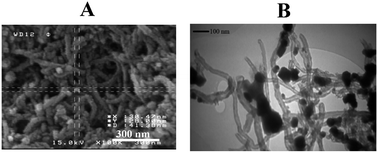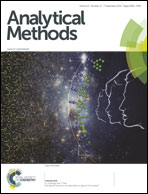Retracted Article: NiFe2O4 nanoparticles decorated with MWCNTs as a selective and sensitive electrochemical sensor for the determination of epinephrine using differential pulse voltammetry†
Abstract
A glassy carbon electrode was modified with nickel-ferrite magnetic nanoparticles and decorated with multiwall carbon nanotubes (NiFe2O4–MWCNTs). Differential pulse voltammetry was then used to investigate the electrochemical behavior of epinephrine at the surface of the modified electrode. The properties of the nanocomposite were also characterized using different techniques. The electrode showed an excellent synergic effect on epinephrine oxidation. At the optimum pH level, the electrode's response in 0.1 mol L−1 phosphate solution was proportional to the concentration of epinephrine in the range of 0.9–800.0 μmol L−1 with a detection limit of 0.09 μmol L−1. The effects of different potentially interfering substances on the epinephrine signal were also studied. Finally, the sensor was evaluated with respect to its reproducibility and stability. It was found that the modified electrode had a good sensitivity, selectivity, and reproducibility for the determination of epinephrine in real samples.


 Please wait while we load your content...
Please wait while we load your content...